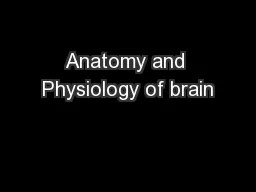

Brain cells Neurons and neuroglia neuroglia In CNS In PNS Asrocytes Schwann cells Oligodendrocytes Satellite cells Microglia Ependymal cells Neuron Basic units of nervous tissue ID: 599764
Download Presentation The PPT/PDF document "Anatomy and Physiology of brain" is the property of its rightful owner. Permission is granted to download and print the materials on this web site for personal, non-commercial use only, and to display it on your personal computer provided you do not modify the materials and that you retain all copyright notices contained in the materials. By downloading content from our website, you accept the terms of this agreement.
Slide1
Anatomy and Physiology of brainSlide2
Brain cells
Neurons and
neuroglia
neuroglia
In CNS
In PNS
Asrocytes
Schwann cells
Oligodendrocytes
Satellite cells
Microglia
Ependymal
cellsSlide3
Neuron
Basic units of nervous tissue
Function as electrical impulse generation and transmission.
Cannot regenerate when damagedSlide4
Neuroglia/Glial cells
Makes half of the volume of CNS
Smaller than neurons and 5-50 times more numerous than neurons.
Do not propagate nerve impulses
Can regain after injury, highly growing.Slide5
Astrocytes
Star shaped cells, have many processes, largest and most numerous
Two types of astrocytes-protoplasmic and fibrous
Processes of astrocytes make contact with blood capillaries,
pia
matter and neurons.Slide6
Functions of astrocytes
strength to support neurons.
blood brain barrier.
growth and interconnection of neurons.
chemical environment for generation of nerve impulses by neurons.
learning and memorySlide7
Oligodendrocytes:
These resemble astrocytes but have fewer processes and smaller in size.
Maintain myelin sheath around the CNS axons.
A single
oligodendrocyte
may
myelinate
several neurons.Slide8
Microglia:
Small in size, contains spindle like projections
Function as phagocytes and clear cell debrisSlide9
Ependymal cells:
Cuboidal to columnar cells contain
cillia
and
microvilli
.
Lines the
ventricals
of brain and central canal of spinal cord.
Produce, monitor and assist in CSF circulation.
Form blood cerebrospinal fluid
barrior
.Slide10
Schwann cells:
Form myelin sheath around the neurons.
Single cell can line only one axon.
Participate in axon regeneration.Slide11
Satellite cells:
Surrounds the cell bodies of neurons in PNS ganglia.
Exchange of materials between neuronal cell bodies and interstitial fluid.Slide12
Meninges:Slide13
CSF circulationSlide14
C
S
F
C
I
R
C
U
L
A
T
I
O
NSlide15
CSF composition
Normal CSF secretion is 20 ml/hr or 480 ml/day
Total volume is 80-150 ml
Carries oxygen and nutrients
Contains glucose, protein, lactic acid, urea,
cations
( Na
+
, K
+
, Ca
2+
, Mg
2+
) and anions (
Cl
, HCO
3
-
)
Functions are mechanical support, chemical and nutritional.Slide16
Brain stem:
Consists of 3 parts:
Medulla
ablongata
Pons
Mid brainSlide17
Medulla ablongata
contains sensory and motor tracts extends between the brain and spinal cord.
Contains cardiovascular centre
Medullary
rythmicity area of respiratory centre
Responsible for vomiting, coughing, sneezing, swallowing and hiccupping.
Sensitive to touch, vibration and
proprioception
.
Contains 5 pairs of cranial nerves:
Vestibulocochlear
VIII
Glossopharyngeal
IX
Vagus
X
Accessory XI
Hypoglossal XII
Damage to this part cause cranial nerve alterations at the same side and paralysis in opposite side.Slide18
Pons
contains
pneumotaxic
area and apneustic
area which helps in respiration.
Have 4 pairs of cranial nerves:
Trigeminal V
Abducens
VI
Facial VII
Vestibulocochlear
VIIISlide19
Mid brain
connects cerebrum to medulla,
pons
and spinal cord.
Reflex centre for visual activities
Helps in tracking moving objects
Helps in scanning stationary objects
Eyes, head and neck movements with moving objects
Startle reflex
Sudden movement of head with noise
Have
substantia
nigra
which release dopamine and also responsible for subconscious muscle activities.Slide20
RAS- reticular activating systembrain stem consists of small clusters of neuronal cell bodies.
It maintains consciousness
Awakening from sleep
Muscle tone maintenance Slide21
cerebellumSkilled skeletal muscle movements
Posture and balance
Cognition and language processing